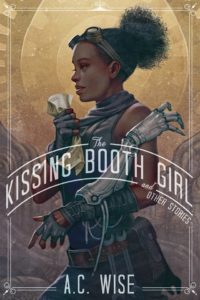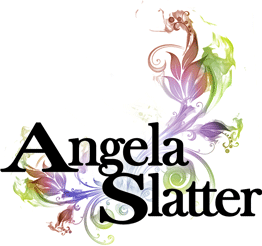 A.C. Wise was born and raised in Montreal and currently lives in the Philadelphia area. Her short stories have appeared, or are forthcoming, in publications such as Clarkesworld, Uncanny, Tor.com and The Year’s Best Dark Fantasy and Horror 2017, among other places. Her collections, The Ultra Fabulous Glitter Squadron Saves the World Again, and The Kissing Booth Girl and Other Stories, are both published by Lethe Press. In addition to her fiction, she co-edits Unlikely Story, and contributes a monthly review column to Apex Magazine. Her Women to Read and Non-Binary Authors to Read series can be found at www.acwise.net, along with various other odds and ends. You can also find her on twitter as @ac_wise, most often shouting about excellent short fiction.
A.C. Wise was born and raised in Montreal and currently lives in the Philadelphia area. Her short stories have appeared, or are forthcoming, in publications such as Clarkesworld, Uncanny, Tor.com and The Year’s Best Dark Fantasy and Horror 2017, among other places. Her collections, The Ultra Fabulous Glitter Squadron Saves the World Again, and The Kissing Booth Girl and Other Stories, are both published by Lethe Press. In addition to her fiction, she co-edits Unlikely Story, and contributes a monthly review column to Apex Magazine. Her Women to Read and Non-Binary Authors to Read series can be found at www.acwise.net, along with various other odds and ends. You can also find her on twitter as @ac_wise, most often shouting about excellent short fiction.
1. First of all, what do new readers need to know about A.C. Wise?
Let’s see. I’m primarily a short fiction writer. I enjoy playing around with various sub-genres, but most of my work tends towards the dark and the weird. I have two short story collections out from Lethe Press, one a collection of interconnected stories titled The Ultra Fabulous Glitter Squadron Saves the World Again, and the other a more traditional short story collection mixing reprints and a few originals titled The Kissing Booth Girl and Other Stories. On the non-writing side of things, I have two adorable corgis whose pictures frequently show up on Instagram and Twitter. Alas, my adorable kitten rarely stays still long enough for pictures. Also, I’m Canadian.
2. Your Women to Read lists are invaluable – how do you go about finding all those stories? And the time to read!
I’m so glad you enjoy them! I love helping folks find new-to-them authors, and pushing myself to discover new-to-me authors and works as well. The Women to Read and Non-Binary Authors to Read series are a perfect excuse to do both. As for finding the time, I’m lucky enough – or unlucky enough, depending on your perspective – to have a long train commute to and from work. It’s about an hour each way, so I get a lot of reading done!
3. What was the process for putting together your collection The Kissing Booth Girl and Other Stories? 
I chose a lot of the stories based on my personal favorites. I also tried to get a mix of older and newer works, and things that might have had a narrower distribution in their original publication. I wanted the collection to be an overview of sorts, a representative sampling of my work.
4. What does your work day look like – where do you fit everything in?
My day job also involves writing, but of a different kind, grantwriting for a museum. Even though it’s still putting words on a page, it engages a different part of my brain, so I have yet to burn out. In a way, it’s been helpful in terms of learning to brutally cut and slash to fit within restrictive word counts. As much as I might love a sentence, sometimes I just have to let it go. As for creative writing, I do my best to fit in at least a little bit of writing or editing on my lunch hour, and I can usually get a few solid hours in on weekends, which is always lovely. Of course, it doesn’t always work out that perfectly, but I do my best.
5. What was the inspiration behind “When the Stitches Come Undone” in Children of Lovecraft?
It was one of those rare (for me at least) stories where the title came first. It popped into my head, and I immediately started wondering where the stitches were, what they were holding together, and of course, what happened when they came undone. As the story unfolded, the themes I most wanted to explore were the ideas of seeing and being seen, sacrifice, and consumption and being consumed as an act of love, if rather twisted one. Hopefully it all worked!
 6. What do you like about writing Lovecraftian fiction?
6. What do you like about writing Lovecraftian fiction?
There’s something weirdly appealing about the notion of a vast and uncaring universe, cosmic horror that rolls right over humanity without even realizing it’s there. The fact that many of Lovecraft’s monsters, and monstrous geographies, are meant to be indescribable or incomprehensible to the human mind is another appealing aspect. It leaves room for the imagination. Obviously Lovecraft has his problematic elements, so there’s also joy in reclaiming his spaces and populating them with women, queers, people of color, and other marginalized folk either left out or actively demonized in his original writing.
7. Can you remember the first story you read that made you think “I want to be a writer”?
I can’t remember a specific story, but I remember reading Ellen Datlow and Terri Windling’s fairy tale anthologies and thinking “yes, I want to write that”. Retold fairy tales were some of the earliest works I managed to get published. Retold fairy tales can be an excellent training ground for a new author. Seeing how stories work, taking familiar elements and breaking them apart to build something new is a great way to learn how stories work, and a good jumping off point for learning to tell stories of your own. At least that’s how it worked for me. The framework of a known tale was a safe place to try out new styles and voices and find my way into the kind of stories I wanted to tell.
8. Which five writers have been your biggest influences?
Agh! That’s a tough question. Ray Bradbury is certainly one of them. I fell in love with his work at just the right age, and I don’t think I’ll ever get over that love and the way it’s influenced my own work. Caitlin Kiernan and Jeff VanderMeer are certainly in the mix as well for their style, their darkness, the way they both have a knack for hinting at hidden depths and larger worlds than what is on the page. Even though they’re very different writers, various of their works have filled me with a sense of creeping unease and dread that I can’t quite put a finger on, but aspire to in my own writing. I’m also constantly inspired and influenced by the writers around me publishing new work today – some I’ve been lucky enough to meet at conventions, or interact with online, or share tables of contents with, and some I simply admire from afar. (There, I either cheated and included far too many authors, or two few, depending on how you count.)
9. You can take five books to a desert island: which ones do you choose? 
Only five?! What a cruel question! Is there a Tardis equivalent of a book that hides other books inside it, and keeps unfolding new things to read as they’re required by the reader? If not, I couldn’t possibly choose. I have old favorites of course, but then think of all the new things I’d be missing out on! Clearly I’ll just have to go to a desert island with a library on it. Or maybe I should just be practical and say I’d take things like A Guide to Building Boats with Limited Resources, Shelters and You, and Spear-Fishing for Dummies, assuming this is the sort of island I’m stranded on, where I need to use my wits to survive.
10. What’s next for A.C. Wise?
I have a handful of stories coming out in 2017, and I’m working on a handful more. I’ll continue writing my Words for Thought review column for Apex, along with Women to Read, and Non-Binary Authors to Read for my blog. As for the next big project…well, I have settled on that yet. Ideas are percolating, but I haven’t committed to one yet. I’m bad at decisions. (See the two questions above for evidence!)

